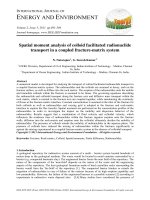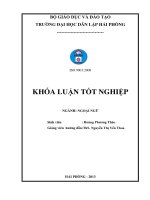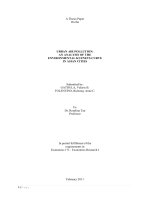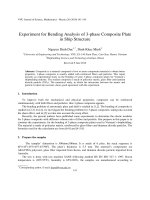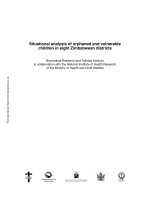Thermal decomposition analysis of simulated high-level liquid waste in cold-cap
Bạn đang xem bản rút gọn của tài liệu. Xem và tải ngay bản đầy đủ của tài liệu tại đây (1.3 MB, 7 trang )
EPJ Nuclear Sci. Technol. 2, 44 (2016)
© K. Kawai et al., published by EDP Sciences, 2016
DOI: 10.1051/epjn/2016038
Nuclear
Sciences
& Technologies
Available online at:
REGULAR ARTICLE
Thermal decomposition analysis of simulated high-level liquid
waste in cold-cap
Kota Kawai*, Tatsuya Fukuda, Yoshio Nakano, and Kenji Takeshita
Research Laboratory for Nuclear Reactor, Tokyo Institute of Technology, 2-12-1-N1-2, Ookayama, Meguro-ku, Tokyo 152-8550,
Japan
Received: 19 October 2015 / Received in final form: 30 September 2016 / Accepted: 8 November 2016
Abstract. The cold cap floating on top of the molten glass pool in liquid fed joule-heated ceramic melter plays an
important role for operation of the vitrification process. A series of such phenomena as evaporation, melting and
thermal decomposition of HLLW (high-level liquid waste) takes place within the cold-cap. An understanding of
the varied thermal decomposition behavior of various nitrates constituting HLLW is necessary to elucidate a
series of phenomena occurring within the cold-cap. In this study, reaction rates of the thermal decomposition
reaction of 13 kinds of nitrates, which are main constituents of simulated HLLW (sHLLW), were investigated
using thermogravimetrical instrument in a range of room temperature to 1000 °C. The reaction rates of the
thermal decompositions of 13 kinds of nitrates were depicted according to composition ratio (wt%) of each
nitrate in sHLLW. It was found that the thermal decomposition of sHLLW could be predicted by the reaction
rates and reaction temperatures of individual nitrates. The thermal decomposition of sHLLW with borosilicate
glass system was also investigated. The above mentioned results will be able to provide a useful knowledge for
understanding the phenomena occurring within the cold-cap.
1 Introduction
In the closed fuel cycles, high-level liquid waste (HLLW) is
generated from reprocessing of spent nuclear fuel. HLLW
possesses intrinsic characteristics such as decay heat,
corrosiveness and generation of hydrogen associated with
radiolysis [1,2]. Thus, long time storage of HLLW is
difficult in terms of confinement and management of
radioactive materials because of its liquid state. Therefore,
HLLW is immobilized into borosilicate glass matrix for safe
long-time storage. The immobilized HLLW is called
vitrified waste. Prior to the final disposal in deep geological
repository, vitrified waste should be cooled for 30–50 years
to achieve decrease of decay heat.
HLLW contains 31 kinds of nitrates which consist of
fission products, Na from alkaline rinse, P from TBP
degradation products, some insoluble particles such as Zr
fines from the cladding of the fuel elements, Mo and
platinum group metals (Pd, Ru and Rh) [3].
In the vitrification process, the cold cap floating on top
of the molten glass pool in liquid fed joule-heated ceramic
melter plays an important role for its operation. A series of
such phenomena as evaporation, melting and thermal
decomposition of HLLW takes place within the cold-cap.
* e-mail:
The contact with glass beads results in further chemical
reactions to incorporate all waste constituents, either as
oxides of other compounds into the glass structure. The
cold-cap formation and conversion to glass take place
under non-isothermal conditions in a range of room
temperature to 1200 °C. It depends on the processing
parameters and properties of the various chemical elements
of HLLW. An understanding of the various thermal
decomposition behavior of many nitrates constituting
HLLW is necessary to elucidate a series of phenomena
occurring within the cold-cap. Some works such as
developments of simulation model in terms of heat balance,
kinetic analysis of reactions, decomposition of individual
chemicals used for the UK solution by means of thermal
balance and so on have been reported on the study of coldcap [4–9]. However, there are few studies which investigate
interaction among constituents of HLLW for cold-cap
reaction. In this study, we investigated thermal decomposition of nitrates constituting HLLW at each temperature
region under an elevated temperature process by the mean
of reaction rate. In addition, the map of thermal
decomposition rate vs temperature for the nitrates
constituting sHLLW was depicted according to the
composition ratio of each nitrate that was contained in
sHLLW in a range of room temperature to 1000 °C in order
to simulate the thermal decomposition of sHLLW.
Moreover, we investigated effects of addition of borosilicate
This is an Open Access article distributed under the terms of the Creative Commons Attribution License ( />which permits unrestricted use, distribution, and reproduction in any medium, provided the original work is properly cited.
2
K. Kawai et al.: EPJ Nuclear Sci. Technol. 2, 44 (2016)
glass for the thermal decomposition behavior of nitrates
constituting HLLW in order to simulate practical phenomena occurring in cold-cap. These results lead to further
clarification of transport phenomena and reactions occurring over a range of room temperature to 1200 °C in coldcap.
2 Experimental
Table 1 shows the composition of sHLLW used in this
study. Composition of HLLW is determined by private
communication with Japan Nuclear Fuel Limited which is
Japanese reprocessing company based on the book
“Nuclear chemical engineering” written by Benedict et al.
[10]. The sHLLW was evaporated to dryness on a hot plate
at 70 °C in order to obtain the dried-sHLLW.
The thermal decomposition reaction of 13 kinds of
nitrates, which are main constituents of sHLLW (corresponding approximately to 93.3 mol% of sHLLW), with
different chemical and physical properties were investigated using thermogravimetrical instrument (TG: TGA-50,
SHIMADZU). Table 2 shows 13 kinds of reagents. Ru was
omitted in this study due to cost, and Mo was also omitted
because thermal decomposition of sodium molybdate
dehydrate from room temperature to 1000 °C is only
dehydration which is occurring at around 100 °C. NaNO2
was used as sodium nitrate for the following reasons.
Thermal decomposition of sodium nitrate under isothermal
conditions at around 600 °C is sequential reaction, which is
NaNO3 → NaNO2 → Na2O. The fractional reaction a is
defined as a = (mini À mt)/(mini À mfin); where mini, mfni
and mt are the weight at initial, final and a given time,
respectively. The a value is 0.295 for NaNO3 → NaNO2
reaction step and 0.705 for NaNO2 → Na2O reaction. The
thermal decomposition of sodium nitrate gradually starts
from 550 °C and the sequential reaction cannot be
confirmed under non-isothermal (1–10 °C/min) [11,12].
This suggests that NaNO3 → NaNO2 reaction proceeds
more rapidly than NaNO2 → Na2O so that NaNO2 → Na2O
reaction step is rate-limiting reaction. For this reason, as
the starting reagent, sodium nitrate (NaNO3) is replaced
by sodium nitrite (NaNO2).
The TG measurements were conducted with heating
rate of 5 °C/min in a range of room temperature to 1000 °C
at flow rate, 75 cm3/min of N2 gas in order to evaluate the
thermal decomposition occurring under inert atmosphere.
The reaction rates of thermal decomposition of the nitrates
were calculated on the basis of the TG curves. The map of
their reaction rates and reaction temperatures was
described over their reaction temperature ranges under
heating rate of 5 °C/min. In addition, chemical compounds
were described in the map. Their compounds are estimated
stoichiometrically based on TG curves.
The thermal decomposition reaction of dried-sHLLW
and each nitrate included in the dried-sHLLW with
borosilicate glass powder were investigated as well. The
composition of used borosilicate glass is listed in Table 3,
which are determined by private communication with
Japan Nuclear Fuel Limited as well. The borosilicate glass
beads were ground to powder of 75 mm to 100 mm in
Table 1. Composition of simulated high-level liquid
waste.
Element
Concentration
[mol/L]
Oxide concentration
[g/L]
H
Na
Nd
Zr
Gd
Ce
Cs
Mo
Fe
La
Ru
Mn
Ba
Pr
Pd
Sr
Sm
Y
Cr
Rh
P
Te
Ni
Ag
Others
1.38
1.005
0.0615
0.0512
0.0364
0.0363
0.0358
0.0321
0.0307
0.0225
0.0219
0.0189
0.0161
0.0159
0.0155
0.0124
0.00898
0.00815
0.0063
0.00501
0.0043
0.00399
0.00109
0.000966
0.00483
31.1
10.3
6.31
6.6
6.25
5.04
4.62
2.45
3.67
2.91
1.34
2.47
2.71
1.9
1.28
1.57
0.92
0.479
0.636
0.305
0.796
0.814
0.112
0.2978
Table 2. Used reagent for 13 kinds of elements (Wako:
Wako Pure Chemical Industries, Ltd., Kanto: Kanto
Chemical Co., Inc.).
Element
Reagent
Reagent-grade
Na
Nd
Zr
Gd
Ce
Cs
Fe
La
Mn
Ba
Pr
Pd
Sr
NaNO2
Nd(NO3)3·6H2O
ZrO(NO3)2·2H2O
Gd(NO3)3·6H2O
Ce(NO3)·6H2O
CsNO3
Fe(NO3)3·9H2O
La(NO3)3·6H2O
Mn(NO3)2·6H2O
Ba(NO3)2
Pr(NO3)3·6H2O
Pd(NO3)2
Sr(NO3)2
>98.5%,
99.5%,
>97.0%,
99.5%,
>98.0%,
99.9%,
>99.0%,
99.9%,
>98.0%,
99.9%,
99.9%,
>97.0%,
>98.0%,
Kanto
Wako
Wako
Wako
Wako
Wako
Wako
Wako
Wako
Wako
Wako
Wako
Wako
K. Kawai et al.: EPJ Nuclear Sci. Technol. 2, 44 (2016)
3
Table 3. Composition of borosilicate glass.
Oxide composition
Concentration ratio [wt%]
SiO2
B2O3
Al2O3
Li2O
CaO
ZnO
Na2O
60
18.2
6.4
3.8
3.8
3.8
4.0
diameter using an alumina mortar. The weight ratio of
dried-sHLLW or nitrate to the borosilicate glass mixture
was 40 wt%.
Fig. 1. TG curve and reaction rate of the thermal decomposition
of Fe(NO3)3·9H2O at heating rate of 5 °C/min.
3 Results and discussion
3.1 Thermal decomposition behavior of constituents
of simulated HLLW
Figure 1 shows the reaction rate of thermal decomposition
of iron nitrate [Fe(NO3)3·9H2O]. It was dehydrated to
produce Fe(NO3)3. Then, it reacted to Fe2O3 in the low
temperature range of 100 to 200 °C.
Figure 2 shows the reaction rate of thermal decomposition of zirconium nitrate [ZrO(NO3)2·2H2O]. It was
dehydrated to ZrO(NO3)2 in the range of room temperature to 100 °C. ZrO(NO3)2 was decomposed to Zr2O3(NO3)
and finally to ZrO2 in the range of 100 to 400 °C.
Figure 3 shows the reaction rate of thermal decomposition of gadolinium nitrate [Gd(NO3)3·6H2O]. It was
dehydrated to Gd(NO3)3 at around room temperature to
300 °C, Gd(NO3)3 was decomposed to GdONO3 at around
400 °C, finally to Gd2O3. Reaction step 1 (Gd(NO3)3 →
GdONO3), step 2 (GdONO3 → Gd2O3) proceeded sequentially at around 400 °C (STEP 1), 500 °C to 600 °C (STEP
2), respectively.
Figure 4 shows the reaction rate of thermal decomposition of NaNO2. It was decomposed to Na2O in the region
above 600 °C. Furthermore, Na2O is sublimated above a
temperature of 800 °C. The thermal decomposition of other
9 kinds of nitrates were also investigated as well. The
results are summarized in Table 4. Iron nitrate was
decomposed in the temperature region lower than 200 °C.
The nitrates of lanthanoid series such as lanthanum,
neodymium and gadolinium nitrate were decomposed in
the middle range of 200 to 600 °C. Alkali metal and
alkaline-earth metal such as strontium, cesium, barium and
sodium were decomposed in the high temperature region of
600 to 1000 °C.
In Figure 5, the reaction rates of the thermal
decompositions of 13 nitrates were depicted according
to composition ratio (wt%) of each nitrate in a range of
room temperature to 1000 °C. The presence of Na is
dominant in sHLLW as shown in Table 1. The reaction
rate curves for 13 nitrates were superimposed on a graph
of reaction rates vs temperature, as shown by a red line in
Figure 6. The reaction rate curve observed from thermal
Fig. 2. TG curve and reaction rate of the thermal decomposition
of ZrO(NO3)2·2H2O at heating rate of 5 °C/min.
STEP1
STEP2
Fig. 3. TG curve and reaction rate of the thermal decomposition
of Gd(NO3)3·6H2O at heating rate of 5 °C/min.
decomposition of dried-sHLLW (black line) was also
depicted in the same figure. As a result, the characteristic
peaks of thermal decomposition of dried-sHLLW were
fitted with overlapped reaction rates of thermal decomposition of their nitrates, especially the peaks around
400 °C and 750 °C corresponding to thermal decomposition of lanthanum nitrates and sodium nitrate. However,
K. Kawai et al.: EPJ Nuclear Sci. Technol. 2, 44 (2016)
4
Fig. 4. TG curve and reaction rate of the thermal decomposition
of NaNO2 at heating rate of 5 °C/min.
the disappearance of iron nitrate decomposition peak
and the appearance of peaks at 300 °C and 600 °C were
observed in Figure 6. It is assumed that iron nitrate is
decomposed with other chemical substances and thermal
decomposition of alkali and alkaline-earth metal nitrates
was promoted with other chemical substances at 600 °C.
Especially, contribution of decomposition of sodium
nitrate would be dominant. Therefore, it was found that
the thermal decomposition of dried-sHLLW could be
predicted from the relation between the reaction rates and
reaction temperatures for their nitrates. Investigation of
disappearance and appearance of peaks is a challenge for
the future.
Fig. 5. Thermal decomposition rate of 13 kinds of nitrates at
heating rate of 5 °C/min, which were depicted according to
composition ratio of each nitrate in sHLLW.
3.2 Thermal decomposition behavior of constituents/
borosilicate glass system
In the cold-cap floating on molten glass, HLLW and
borosilicate glass coexist. Studying their interaction is
necessary to understand a series of phenomena occurring
within the cold-cap. Then, the thermal decomposition of
Fig. 6. Comparison between the thermal decomposition rate of
sHLLW ( black line) and that overlapping thermal decomposition
rates of 13 kinds of nitrates included in sHLLW (red line).
Table 4. Map of reaction property vs. temperature.
Nitrate
100°C
150°C
200°C
NaNO2
250°C
300°C 350°C
Melting
Dehydrating→Nd(NO3)3
Nd(NO3)3 • 6H2O
Dehydrating
→ZrO(NO3)2
ZrO(NO3)2 • 2H2O
Decomposition
→Zr2O3(NO3)
Decomposition
→ZrO2
Dehydrating
Ce(NO3)3
Decomposition
→Ce2O3
Dehydrating
Gd(NO3)3
Gd(NO3)3 • 6H2O
Ce(NO3)3 • 6H2O
CsNO3
Fe(NO3)3 • 9H2O
Decomposition
→NdO(NO3)
Decomposition→Nd2O3
Decomposition
→GdO(NO3)
Decomposition→Gd2O3
Melting
Dehydrating
Fe(NO3)3
Decomposition
→LaO(NO3)
Dehydrating
La(NO3)3
Dehydrating→Mn(NO3)2
Sr(NO3)2
650°C
700°C 750°C 800°C 850°C 900°C 950°C 1000°C
Decomposition→Na2O→Sublimation
Decomposition→Cs2O→Sublimation
Decomposition
MnO(NO3)
Decomposition→La2O3
Decomposition
→MnO
Decomposition→BaO
Ba(NO3)2
Dehydrating
Pr(NO3)3
Pr(NO3)3 • 6H2O
Pd(NO3)2
600°C
Decomposition
→Fe2O3
La(NO3)3 • 6H2O
Mn(NO3)2 • 6H2O
Phenomena and Temperature
400°C
450°C
500°C 550°C
Decomposition
→PdO
Decomposition
→PrO(NO3)
Decomposition
→Pr2O3
Decomposition→Pd
Decomposition→SrO
K. Kawai et al.: EPJ Nuclear Sci. Technol. 2, 44 (2016)
13 nitrates coexisting with borosilicate glass powder (75 to
100 mm in diameter) was investigated by the same way as
that described in the former section.
Figure 7 shows the thermal decomposition rate of
NaNO2 with borosilicate glass powder in a range of room
temperature to 800 °C. The weight ratio, the vertical axis in
the figure, means the ratio of weight of remaining NaNO2 to
initial weight. Then, it was assumed that the weight of
borosilicate glass powder is constant during the reaction.
Thermal decomposition of NaNO2 in the presence of
borosilicate glass powder took place at much lower temperature than that of the sodium nitrite itself (Fig. 4). Similar
phenomena were reported by Abe et al. [13]. From the viewpoint of thermodynamics, the following chemical reactions
can occur in the presence of borosilicate glass. These
reactions indicate that the thermal decomposition of sodium
nitrite is promoted and occurring at low temperature.
5
STEP3
STEP2
STEP1
Fig. 7. TG curve obtained by the thermal decomposition of
NaNO2 in the presence of borosilicate glass powder at heating rate
of 5 °C/min (solid line) and the thermal decomposition rate
calculated from the differential of the TG curve (dashed line).
STEP 1
2NaNO2 ¼ Na2 O2 ỵ 2NO
1ị
Na2 O2 ỵ NaNO2 ẳ Na2 O ỵ NaNO3
2ị
Na2 O ỵ B2 O3 ẳ Na2 OB2 O3
3ị
3NaNO2 ẳ NaNO3 ỵ Na2 O ỵ 2NO
4ị
2NaNO2 ẳ Na2 O2 ỵ 2NO
5ị
1
Na2 O2 ẳ Na2 O ỵ O2
2
6ị
Na2 O ỵ SiO2 ẳ Na2 OSiO2
7ị
2NaNO3 ẳ Na2 O2 ỵ 2NO ỵ O2
8ị
1
Na2 O2 ẳ Na2 O ỵ O2
2
9ị
3
2NaNO3 ẳ Na2 O ỵ 2NO ỵ O2
2
10ị
Na2 O ỵ SiO2 ẳ Na2 OSiO2 :
11ị
STEP 2
Fig. 8. TG curve obtained by the thermal decomposition of Gd
(NO3)3·6H2O in the presence of borosilicate glass powder at
heating rate of 5 °C/min (solid line) and the thermal decomposition
rate calculated from the differential of the TG curve (dashed line).
STEP 3
Moreover, Na2O may not be sublimated in the presence of
borosilicate glass as shown in Figure 7. For other alkali metal
and alkaline-earth metal nitrates, the thermal decomposition of their nitrates also took place at lower temperatures
due to the presence of borosilicate glass powder.
Figure 8 shows the thermal decomposition rate of
gadolinium nitrate in the presence of borosilicate glass
powder. In this case, the behavior of its thermal
decomposition is similar to the case without borosilicate
Fig. 9. Thermal decomposition rate of 13 kinds of nitrates in the
presence of borosilicate glass powder at heating rate of 5 °C/min,
which are depicted according to composition ratio of each nitrate
in sHLLW.
glass described in Figure 3. Thus, the effects by the
addition of borosilicate glass were not observed. For other
lanthanides and iron nitrates, the effects of the addition of
borosilicate glass were not observed as well.
Figure 9 shows the thermal decompositions rates of 13
nitrates in the presence of borosilicate glass powder, which
were depicted according to composition ratio (wt%) of each
6
K. Kawai et al.: EPJ Nuclear Sci. Technol. 2, 44 (2016)
Fig. 10. Comparison between the thermal decomposition rate of
sHLLW (black line) and that obtained by overlapping the
thermal decomposition rates of 13 kinds of nitrates (red line) in
the presence of borosilicate glass powder.
nitrate. The temperature range was from room temperature to 800 °C. In order to compare the thermal
decomposition of dried-sHLLW and those of 13 nitrates
in the presence of borosilicate glass, the overlapping curve
of the thermal decomposition rates of 13 nitrates in the
presence of borosilicate glass powder is shown with a red
line in Figure 10. The thermal decomposition rate of driedsHLLW in the presence of borosilicate glass powder is
shown with a black line in the same figure. The
decomposition rates of dried-sHLLW below 500 °C were
not changed with and without borosilicate glass. However,
the thermal decomposition rates of dried-sHLLW in the
presence of borosilicate glass powder above 500 °C is
dramatically changed compared to the overlapping of the
thermal decomposition rates of 13 nitrates in the presence
of borosilicate glass powder, especially the part of the
sodium nitrate decomposition with glass powder. In
Figure 10, there are no peak corresponding to STEP 3 in
Figure 7. It seems that the sodium nitrate decomposition
was promoted by the presence of other chemical substances
included in sHLLW. Although the thermal decomposition
of dried-sHLLW with borosilicate glass powder tends to
occur at lower temperature than that of sHLLW above
500 °C, the thermal decomposition rate of dried-sHLLW
with borosilicate glass powder could be described by
overlapping the thermal decomposition rates of 13 nitrates.
Investigation of interaction between sodium nitrate and
other chemical substances in the presence of borosilicate
glass is also a challenge for the future as well as the former
section.
4 Conclusions
The thermal decomposition of 13 nitrates which are main
constituents of sHLLW was investigated using thermalgravimetrical analysis in the range of room temperature to
1000 °C. At the low temperature range of room temperature to 200 °C, iron and palladium nitrates decomposed to
oxide. At the middle temperature range of 200 to 600 °C,
zirconium, manganese and lanthanoid series nitrates
decomposed to oxide. At the high temperature range of
600 to 1000 °C, alkali and alkaline-earth metal nitrates
decomposed to oxide. The overlapped curve of the thermal
decomposition rates for 13 kinds of nitrates, which
includes Na, Nd, Zr, Gd, Ce, Cs, Fe, La, Mn, Ba, Pr,
Pd and Sr, was almost fitted with the curve of the thermal
decomposition rate of dried-sHLLW. It was also found
that iron nitrate, alkali and alkaline-earth metal nitrates
are probably decomposed with other chemical substances
included in sHLLW. In addition, the thermal decomposition of each nitrate with borosilicate glass powder was
investigated as well. As the results, it was observed that
the thermal decomposition of alkali metal and alkalineearth metal nitrates were affected by the borosilicate
glass. For other nitrates such as lanthanides, zirconium
nitrate, iron nitrate and so on, the effects of their thermal
decomposition in the presence of borosilicate glass were
not observed. The overlapped curve of the thermal
decomposition rates for 13 nitrates with borosilicate glass
was fitted roughly with the thermal decomposition rates of
dried-sHLLW with borosilicate glass powder. It was found
that most of the thermal decomposition behavior of
HLLW within the cold-cap is able to be predicted by the
thermal decomposition behavior of the individual nitrates
which are included in HLLW. The thermal decomposition
of sodium nitrate with borosilicate glass powder is
promoted due to some reaction with other chemical
substances included in sHLLW as well as thermal
decomposition of sHLLW. The above results will be able
to provide a useful knowledge for understanding the
phenomena occurring within the cold-cap.
This work is a part of the research supported by Japan Nuclear
Fuel Limited with Grant-in-Aid by the Ministry of Economy,
Trade and Industry.
References
1. N. Nakagiri, T. Miyata, Evaluation of value for hydrogen
release from high-level liquid waste, (IV) À hydrogen release
rate for gamma-ray radiolysis of simulated Purex waste
solutions, J. At. Energy Soc. Jpn. 39, 563 (1998)
2. T. Murakami, Immobilization of high level radioactive
waste in ceramic waste forms, J. Cryst. Soc. Jpn. 25, 168
(1983)
3. H. Matzke, E. Vernaz, Thermal and physicochemical
properties important for the long term behavior of nuclear
waste glasses, J. Nucl. Mater. 201, 295 (1993)
4. R. Pokorny, P. Hrma, Model for the conversion of nuclear
waste melter feed to glass, J. Nucl. Mater. 445, 190
(2014)
5. R. Pokorny et al., Melting of glass batch: model for multiple
overlapping gas-evolving reactions, Thermochim. Acta 541,
8 (2012)
6. J. Chun et al., Cold-cap reactions in vitrification of nuclear
waste glass: experiments and modeling, Thermochim. Acta
559, 32 (2013)
7. R. Pokorny, P. Hrma, Mathematical modeling of cold cap,
J. Nucl. Mater. 429, 245 (2012)
8. K.S. Chun, S.H. Lee, Vitrification of highly active liquid
waste(I) (thermal decomposition of nitrates and additives for
glass-making), J. Korean Nucl. Soc. 9, 211 (1977)
K. Kawai et al.: EPJ Nuclear Sci. Technol. 2, 44 (2016)
9. K.S. Chun, J.B. Morris, Vitrification of highly active liquid
waste(II) (the thermal decomposition of HARVEST feed
slurries and the characterization of the product), J. Korean
Nucl. Soc. 11, 211 (1979)
10. M. Benedict, T.H. Pigford, H.W. Levi, Nuclear
chemical engineering (McGraw-Hill Education, 1981),
2nd ed.
7
11. E.S. Freeman, The kinetics of the thermal decomposition of
sodium nitrate and of the reaction between sodium nitrite
and oxygen, J. Phys. Chem. 60, 1487 (1956)
12. B.D. Bond, P.W.M. Jacobs, The thermal decomposition of
sodium nitrate, J. Chem. Soc. A, 1966, 1265 (1966)
13. O. Abe et al., The reaction of sodium nitrite with silica, Bull.
Chem. Soc. Jpn. 56, 428 (1983)
Cite this article as: Kota Kawai, Tatsuya Fukuda, Yoshio Nakano, Kenji Takeshita, Thermal decomposition analysis of
simulated high-level liquid waste in cold-cap, EPJ Nuclear Sci. Technol. 2, 44 (2016)

